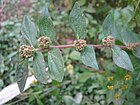Note: This is a project under development. The articles on this wiki are just being initiated and broadly incomplete. You can Help creating new pages.
Difference between revisions of "Euphorbia prostrata - Dugdhikā"
(→Commonly seen growing in areas) |
(→External Links) |
||
| Line 79: | Line 79: | ||
==External Links== | ==External Links== | ||
| − | + | ||
* [https://www.sciencedirect.com/topics/agricultural-and-biological-sciences/euphorbia-hirta Euphorbia Hirta on science direct] | * [https://www.sciencedirect.com/topics/agricultural-and-biological-sciences/euphorbia-hirta Euphorbia Hirta on science direct] | ||
| − | * [https://www.tandfonline.com/doi/pdf/10.1080/13880200701214748 Antimalarial Flavonol Glycosides from Euphorbia hirta] | + | * [https://www.tandfonline.com/doi/pdf/10.1080/13880200701214748 Antimalarial Flavonol Glycosides from Euphorbia hirta Euphorbia Hirta on tandfonline.com] |
[[Category:Herbs]] | [[Category:Herbs]] | ||
Revision as of 22:01, 12 October 2018
Dugdhika is a pantropical weed, possibly native to India. It is a hairy herb that grows in open grasslands roadsides and pathways. It is widely used as a medicinal herb.
Contents
- 1 Uses
- 2 Parts Used
- 3 Chemical Composition
- 4 Common names
- 5 Properties
- 6 Habit
- 7 Identification
- 8 List of Ayurvedic medicine in which the herb is used
- 9 Where to get the saplings
- 10 Mode of Propagation
- 11 How to plant/cultivate
- 12 Commonly seen growing in areas
- 13 Photo Gallery
- 14 References
- 15 External Links
Uses
Cough, Coryza, Bronchitis, Asthma, Worm infestations, Dysentery, Jaundice, Pimples, Gonorrhoea, Digestive problems, Tumours.
Parts Used
Chemical Composition
alkanes, triterpenes, phytosterols, tannins, polyphenols, and flavanoids[1]
Common names
| Language | Common name |
|---|---|
| Kannada | Akkegida |
| Hindi | Lal Dudhi |
| Malayalam | Nelapalai |
| Tamil | Amman Pacharisi |
| Telugu | Nanabala |
| Marathi | NA |
| Gujarathi | NA |
| Punjabi | NA |
| Kashmiri | NA |
| Sanskrit | Nagarjuni, Pusitoa |
| English | equirity |
Properties
Reference: Dravya - Substance, Rasa - Taste, Guna - Qualities, Veerya - Potency, Vipaka - Post-digesion effect, Karma - Pharmacological activity, Prabhava - Therepeutics.
Dravya
Rasa
Tikta (Bitter), Kashaya (Astringent)
Guna
Laghu (Light), Ruksha (Dry), Tikshna (Sharp)
Veerya
Ushna (Hot)
Vipaka
Katu (Pungent)
Karma
Kapha, Vata
Prabhava
Habit
Identification
Leaf
| Kind | Shape | Feature |
|---|---|---|
| Paripinnate | opposite | -4 cm long, 1-1.5 cm wide, oblong-lanceolate, with a pointed tip and a finely toothed margin |
.[2]
Flower
| Type | Size | Color and composition | Stamen | More information |
|---|---|---|---|---|
| Unisexual | 2-4cm long | greenish or pinkish | peduncles reddish brown | Flowering throughout the year and In terminal and/or axillary pseudoracemes |
Fruit
| Type | Size | Mass | Appearance | Seeds | More information |
|---|---|---|---|---|---|
| globular clusters | Inflorescence dense, globular clusters | hairy, 3-lobed capsule, 1.25-2 x 1.5 mm, splitting into three | 1-seeded | Fruiting throughout the year | {{{6}}} |
Other features
List of Ayurvedic medicine in which the herb is used
- Vishatinduka Taila as root juice extract
Where to get the saplings
Mode of Propagation
How to plant/cultivate
Prefers a light well-drained moderately rich loam in an open sunny position[3]
Commonly seen growing in areas
Waste places in lowland, Cultivated fields in lowland, Moist open places
Photo Gallery
References
External Links
- Ayurvedic Herbs known to be helpful to treat Cough
- Ayurvedic Herbs known to be helpful to treat Coryza
- Ayurvedic Herbs known to be helpful to treat Bronchitis
- Ayurvedic Herbs known to be helpful to treat Asthma
- Ayurvedic Herbs known to be helpful to treat Worm infestations
- Ayurvedic Herbs known to be helpful to treat Dysentery
- Ayurvedic Herbs known to be helpful to treat Jaundice
- Ayurvedic Herbs known to be helpful to treat Pimples
- Ayurvedic Herbs known to be helpful to treat Gonorrhoea
- Ayurvedic Herbs known to be helpful to treat Digestive problems
- Ayurvedic Herbs known to be helpful to treat Tumours
- Herbs with Leaves used in medicine
- Herbs with common name in Kannada
- Herbs with common name in Hindi
- Herbs with common name in Malayalam
- Herbs with common name in Tamil
- Herbs with common name in Telugu
- Herbs with common name in Sanskrit
- Herbs with common name in English
- Habit - A small wiry straggler(5m)
- Index of Plants which can be propagated by Seeds
- Herbs that are commonly seen in the region of Waste places in lowland
- Herbs that are commonly seen in the region of Cultivated fields in lowland
- Herbs that are commonly seen in the region of Moist open places
- Herbs








